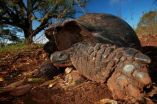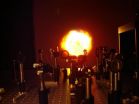(Press-News.org) This press release is available in German.
The Galapagos giant tortoise, one of the most fascinating species of the Galapagos archipelago, treks slowly and untiringly across the volcanic slopes. Scientists of the Max Planck Institute for Ornithology in Radolfzell, together with the Charles Darwin Foundation, have used GPS technology and modern 3D acceleration measurements to find out that especially the dominant male tortoise wanders up to 10 kilometres into the highlands of the island. Only the fully grown animals migrate, the young tortoises stay year round in the lowlands. The reason for this and the question of why the animals don't rest during the dry season are not known yet.
Even Charles Darwin anticipated that the giant tortoises wandered large distances. In the cool dry season, the highlands of Santa Cruz are engulfed in fog which allows the vegetation to grow despite the lack of rain. In the lowlands, however, there is no thick layer of clouds and the tortoises' vegetation is not available year round. Adults, which can weigh up to 250 kilogram, spend the dry season in the higher regions at an elevation of 400 meters above sea level. However, since the food is not as nutritious there, they trek back to the lower zones where there is succulent vegetation in abundance as soon as the rainy season begins.
In order to study the migratory pattern more closely, Stephen Blake from the Max Planck Institute for Ornithology and his colleague Washington Tapia from the Galapagos National Park secured GPS loggers with 3D acceleration monitors onto 17 adult tortoises. This allowed the scientists to determine the animals' exact position and behaviour over a period of two years. In order to gather information on the entire population, the researchers noted the size, sex and location of each tortoise they met on their monthly hikes along the volcanic hillsides. They combined the GPS data with the temperature data and information about availability of vegetation.
The results show that the tortoises have a partial migration system, where not every individual migrates. Only the adult animals wander and only the larger specimens are more likely to move. In June they start their slow, tedious march which can be up to ten kilometres long into the highlands. Adult females remain in the lowlands until they lay their eggs and then they also make their way to the highlands. In contrast, the smaller tortoises stay in the lower elevated areas all year round.
Although giant tortoises are able to survive for up to one year without nourishment, which made them a popular staple for seamen, they nevertheless wander for large distances searching for food as this study shows for the first time. Why don't they just look for a shelter? The question of why the younger animals don't migrate hasn't been answered by the scientists yet. "Either the energy expenditure of this strenuous hike is too high, or there is still enough food available for the smaller animals." Stephen Blake suspects, "perhaps the younger animals can't tolerate the wet cold climate of the higher regions."
In other species, the largest and the most dominant individual does not migrate because it can best defend itself against its competitors. It doesn't have to leave to survive. However, among the Galapagos tortoises, it's usually the largest and most dominant individual which takes on this arduous journey.
Future studies on giant tortoise species of the other Galapagos Islands with varying ecological conditions will show how environment influences the migration scheme of these closely related reptiles. The scientists also want to include factors such as age, size, sex and morphology in their studies to see why the behaviour changes in different lifetime stages and what the trigger of migration is.
Despite the threat of hunting, invasive species such as goats and rats, and the loss of habitat due to man, the Galapagos Tortoise still shows its original migrating behaviour. This and future studies will help to maintain this behaviour with the help of effective measures such as establishing corridors, preserving key habitats, keeping tortoise-friendly roads and maintaining less urban development. Based on its importance to the Galapagos Archipelago ecosystem as an herbivore and seed disperser, the annual migration of the tortoise must be preserved.
INFORMATION:
Original publication
Stephen Blake, Charles Yackulic, Fredy Cabrera, Washington Tapia, James Gibbs, Franz Kümmeth, Martin Wikelski
Vegetation dynamics drive segregation by body size in Galapagos tortoises migrating across altitudinal gradients.
Journal of Animal Ecology, November 20, 2012, JAE-2012-00027.R2
Galapagos tortoises are a migrating species
The large, dominant male Galapagos giant tortoises usually start their annual migration at the beginning of the dry season
2012-11-27
ELSE PRESS RELEASES FROM THIS DATE:
Do missing Jupiters mean massive comet belts?
2012-11-27
Using ESA's Herschel space observatory, astronomers have discovered vast comet belts surrounding two nearby planetary systems known to host only Earth-to-Neptune-mass worlds. The comet reservoirs could have delivered life-giving oceans to the innermost planets.
In a previous Herschel study, scientists found that the dusty belt surrounding nearby star Fomalhaut must be maintained by collisions between comets.
In the new Herschel study, two more nearby planetary systems – GJ 581 and 61 Vir – have been found to host vast amounts of cometary debris.
Herschel detected ...
Researchers study cry acoustics to determine risk for autism
2012-11-27
Autism is a poorly understood family of related conditions. People with autism generally lack normal social interaction skills and engage in a variety of unusual and often characteristic behaviors, such as repetitive movements. While there is no specific medical treatment for autism, some success has been shown with early behavioral intervention.
Understanding the importance of early diagnosis, researchers at Women & Infants' Brown Center for the Study of Children at Risk in collaboration with researchers at University of Pittsburgh have been studying the cry acoustics ...
Flu outbreaks predicted with weather forecast techniques
2012-11-27
Contact: David Hosansky
hosansky@ucar.edu
303-497-8611
Zhenya Gallon
zhenya@ucar.edu
303-497-8607
National Center for Atmospheric Research/University Corporation for Atmospheric Research
Flu outbreaks predicted with weather forecast techniques
BOULDER – Scientists at Columbia University and the National Center for Atmospheric Research have adapted techniques used in modern weather prediction to generate local forecasts of seasonal influenza outbreaks. By predicting the timing and severity of the outbreaks, this system can eventually help health officials ...
Cell Transplantation reports islet cell advancement increases impact on transplantation
2012-11-27
Putnam Valley, NY. (Nov. 27, 2012) – A study published in the current issue of Cell Transplantation (21:8), now freely available on-line at http://www.ingentaconnect.com/content/cog/ct/ , reports that a team of researchers in South Korea have successfully engineered islet cell clusters (ICCs) that will improve pancreatic islet transplantation and offer promise for curing diabetes mellitus.
Carried out by collaborating researchers at three universities in Seoul, Korea, the new process of creating ICCs included delivering a gene to single islet cells that increased their ...
An energy conscious workforce: New research looks at how to encourage staff to go green
2012-11-27
As homeowners we are becoming cannier about turning down the thermostat to save our pennies and the planet but are we as energy conscious when we get to work?
A new £1.3m project, being led by researchers at The University of Nottingham, is to look at people's attitudes to energy consumption in the workplace and how to encourage colleagues to work together in reducing their organisation's carbon footprint.
Drawing on technical expertise at Nottingham's Horizon Digital Economy Research and design skills of experts at The University of Southampton, the five-year study ...
Study suggests different organ-derived stem cell injections improve heart function
2012-11-27
Putnam Valley, NY. (Nov. 27, 2012) – A study published in the current issue of Cell Transplantation (21:8), now freely available on-line at http://www.ingentaconnect.com/content/cog/ct/, has found that when mesenchymal cells derived from skeletal muscle (SM-MSCs) or adipose tissue (ADSCs) were injected into the heart muscle (myocardium) of separate groups of laboratory rats that had suffered a myocardial infarction, rats in both groups experienced significantly improved left ventricle function and smaller infarct size after cell therapy.
The study, carried out by researchers ...
Tracking pollution from outer space
2012-11-27
The thickest layers of global smog — caused by traffic, industry, and natural minerals, among other factors — are found over the world's megacities. But getting an accurate measurement of pollution is no easy task. On-the-ground monitoring stations do not always provide the most accurate picture —monitoring stations depend heavily on local positioning and some cities put stations in urban centers, while others build on the edge of a city.
Now Prof. Pinhas Alpert of Tel Aviv University's Department of Geophysics and Planetary Sciences and head of the Porter School of Environmental ...
Illuminating the no-man's land of waters' surface
2012-11-27
Water repelling molecules are said to be hydrophobic. The hydration – or formation of water interfaces around hydrophobic molecules – is important for many biological processes: protein folding, membrane formation, transport of proteins across an interface, the transmission of action potentials across membranes. It is involved as well in the process of creating mayonnaise, or in the fact that you can get rid of fat with soap. Hydrophobic interfaces although long studied, are poorly understood.
Here's an amusing kitchen-table experiment to illustrate waters unusual properties: ...
Measles vaccine given with a microneedle patch could boost immunization programs
2012-11-27
Measles vaccine given with painless and easy-to-administer microneedle patches can immunize against measles at least as well as vaccine given with conventional hypodermic needles, according to research done by the Georgia Institute of Technology and the Centers for Disease Control and Prevention (CDC).
In the study, the researchers developed a technique to dry and stabilize the measles vaccine – which depends on a live attenuated virus – and showed that it remained effective for at least 30 days after being placed onto the microneedles. They also demonstrated that the ...
Safer spinach? Scientist's technique dramatically reduces E. coli numbers
2012-11-27
URBANA – University of Illinois scientists have found a way to boost current industry capabilities when it comes to reducing the number of E. coli 0157:H7 cells that may live undetected on spinach leaves.
"By combining continuous ultrasound treatment with chlorine washing, we can reduce the total number of foodborne pathogenic bacteria by over 99.99 percent," said Hao Feng, a U of I professor of food science and human nutrition.
According to Feng, the USDA is looking for proposed technologies that can achieve a 4 to 6 log reduction in pathogen cells (a 6 log reduction ...
LAST 30 PRESS RELEASES:
American Meteorological Society announces Rick Spinrad as 2026 President-Elect
Biomass-based carbon capture spotlighted in newly released global climate webinar recording
Illuminating invisible nano pollutants: advanced bioimaging tracks the full journey of emerging nanoscale contaminants in living systems
How does age affect recovery from spinal cord injury?
Novel AI tool offers prognosis for patients with head and neck cancer
Fathers’ microplastic exposure tied to their children’s metabolic problems
Research validates laboratory model for studying high-grade serous ovarian cancer
SIR 2026 delivers transformative breakthroughs in minimally invasive medicine to improve patient care
Stem Cell Reports most downloaded papers of 2025 highlight the breadth and impact of stem cell research
Oxford-led study estimates NHS spends around 3% of its primary and secondary care budget on the health impacts of heat and cold in England
A researcher’s long quest leads to a smart composite breakthrough
Urban wild bees act as “microbial sensors” of city health.
New study finds where you live affects recovery after a hip fracture
Forecasting the impact of fully automated vehicle adoption on US road traffic injuries
Alcohol-related hospitalizations from 2016 to 2022
Semaglutide and hospitalizations in patients with obesity and established cardiovascular disease
Researchers ‘listen in’ to embryo-mother interactions during implantation using a culture system replicating the womb lining
How changing your diet could help save the world
How to make AI truly scalable and reliable for real-time traffic assignment?
Beyond fragmented markets: A new framework for efficient and stable ride-pooling
Can shape priors make road perception more reliable for autonomous driving?
AI tracks nearly 100 years of aging research, revealing key trends and gaps
Innovative techniques enable Italy’s first imaging of individual trapped atoms
KIER successfully develops Korea-made “calibration thermoelectric module” for measuring thermoelectric device performance
Diversifying US Midwest farming for stability and resilience
Emphasizing immigrants’ deservingness shifts attitudes
Japanese eels, climate change, and river temperature
Pusan National University researchers discover faster, smarter heat treatment for lightweight magnesium metals
China’s 2024 Gastroenterology Report: marked progress in endoscopy quality and disease management
Pusan National University researchers uncover scalable method for ultrahigh-resolution quantum dot displays
[Press-News.org] Galapagos tortoises are a migrating speciesThe large, dominant male Galapagos giant tortoises usually start their annual migration at the beginning of the dry season




